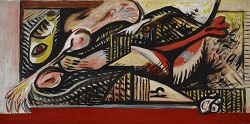Today is the birthday of artist Jackson Pollock, born January 28, 1912. Pollock is well known as the quintessential American Abstract Expressionist painter: the poster child for action painting with his signature all-over drip and splatter paintings. Even Norman Rockwell, in his famous Saturday Evening Post cover illustration The Connoisseur, called upon Pollock’s style as a metaphor for Modern art. Yet Pollock was not the first to come up with the style that earned him the nickname “Jack the Dripper.” There is evidence to support the possibility that Pollock was inspired by the work of a little-known artist named Janet Sobel.
Sobel was a self-taught Ukrainian immigrant who did not begin painting until she was 45. While Sobel’s early work—figurative paintings depicting memories of her childhood in Ukraine—had a “primitive” look, by 1944 she was creating abstract works featuring richly colored canvases of dripped, poured, and blown paint swirling with half-recognizable faces. In 1945 she was part of a juried show called The Women in Peggy Guggenheim’s Art of This Century gallery, and it was there that Jackson Pollock first encountered Sobel’s work… before Pollock himself began making “all-over” drip paintings, the first of which he produced in 1947.
Crystal Bridges has several of Janet Sobel’s works in our permanent collection. Sobel’s painting Hiroshima is slated to be included in the re-installation of the Museum’s Twentieth-Century Art Gallery.
Although Crystal Bridges does not currently have any of Pollock’s drip paintings in our collection, we do have one of the artist’s earlier works, made during a time when he was experimenting with different approaches, before he arrived at the drip and splatter style. Reclining Woman, painted ca. 1938-1941, reveals the artist’s Modernist roots in its abstraction, bright colors, and bold brush strokes, as well as the influence of the work of the Surrealists and of Pablo Picasso (Picasso’s influential work Guernica had been on view at the Museum of Modern Art in New York City at the end of 1939). Though Reclining Woman is very different from the splatter paintings, it gives off something of the same sense of energy and power evidenced in those later works.
Soon, guests to Crystal Bridges will have an opportunity to view Convergence, 1952, one of Jackson Pollock’s famous splatter paintings in the upcoming temporary exhibition Van Gogh to Rothko: Masterworks from the Albright-Knox Art Gallery, opening February 21.






